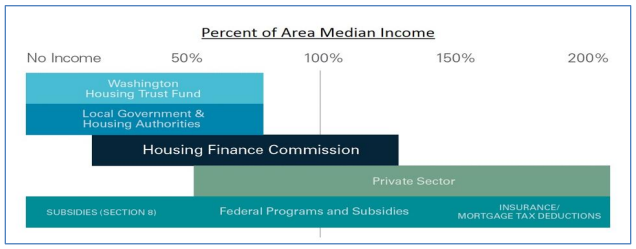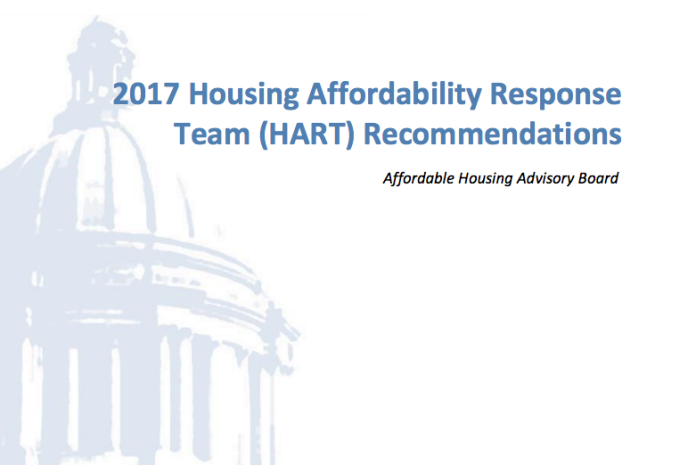A new statewide report on affordable housing has been released by the Washington State Department of Commerce. The Affordable Housing Advisory Board, which is an board managed by the agency, commissioned a comprehensive report on issues facing the provision of affordable housing. A broad set of stakeholders from (AHAB), including representatives from the real estate industry, affordable housing providers, public agencies, and development community, developed the assessment and report. Published in June, the 2017 Housing Affordability Response Team (HART) Recommendations report is broken into three parts to identify factors that impact affordable housing supply:
- Land use factors;
- Permitting, construction, and regulatory factors; and
- Funding and finance factors.
The report, however, largely places responsibility on local governments to address affordable housing issues with little assistance from the state besides adjustments to state law.
Land Use Factors
The report discusses how land use factors impact supply of affordable housing. At the high level, the Growth Management Act is identified as one source, though it is noted largely as a positive impact in that it establishes “directives for how cities and counties should plan for housing, including housing affordable to lower-income households,” and sets an overarching housing goal that “calls for promoting a variety of residential densities and housing types, encouraging the availability of affordable housing for all economic segments of the population, and preservation of existing housing stock.” Other sources identified include local comprehensive plans, countywide planning policies, subarea plans, and buildable lands reports.
However, the report suggests that there are some land use factors that make delivery of affordable housing challenging:
Higher-end housing is more profitable. During the development process for both market-rate and affordable housing projects, significant risk exposures exist for the developer and other parties. This is because the project must be complete before income and anticipated profit is generated. To compensate for this risk, the market-rate developer, investor, and other capital providers establish a minimum expected rate of return on their investment that must be achieved before they will go forward with the project. Thus, the market-rate developer applies a market demand approach, which favors the more profitable housing types favored by high-income earners who tend to reside in urban areas. There is also a shortage of skilled labor within the construction industry, which means there are fewer firms working and competing for projects. The consequence of this combination of factors is that more affordable markets cannot compete with higher-priced markets, or less profitable but more affordable housing types are not produced to the extent they are needed.
And to this, the difficulty in upgrading infrastructure to accommodate big population upswings:
Extending infrastructure is expensive. In many communities, an assessment of land capacity shows that there is sufficient land to accommodate the local share of projected population growth. However, the ability to develop land may vary greatly, based on the availability of sewer, water, roads, and other public services. In many cases, to develop land outside the area currently served by urban services, the first developer is required to carry the cost of bringing infrastructure to serve the parcel. Where development is proposed in already developed areas, there may be concerns about the pressures it puts on existing infrastructure and services.
Recommendations to address this center on giving local governments funding tools to provide housing at all income levels, but low incomes in particular, assisting local governments in the assessing land capacity for development, and providing local governments with resources on how to facilitate affordable housing development. Specific recommendations call for:
- Offering funding to counties and cities to update their Housing, Economic Development, and Capital Facilities Elements in comprehensive plans to reflect policies that support all income levels;
- Standardizing the process for conducting buildable lands analysis and reporting;
- Educating cities on existing affordable housing tools like multifamily tax exemptions; and
- Encouraging cities to reform development regulations and increase zoned development capacity.
Permitting, Construction, and Regulatory Factors
The report highlights some ways that state law mandates certain affordable housing provisions and authorizes discretion in implementing tools through permitting and regulatory frameworks. Cities and counties also have reserved tools to help deliver affordable housing. State law, for instance, requires all cities of 20,000 residents to allow accessory dwelling units in single-family residential areas. Manufactured housing, such as mobile homes, may not be treated differently from other single-family housing. Local jurisdictions may also choose to use incentive zoning, density bonuses in exchange for affordable housing, reduced impact fees on affordable housing, and expediting permitting processes for affordable housing.
The report does, however, identify areas where there are permitting, construction, and regulatory factors that contribute toward less affordable housing.
Shortage of skilled labor. During the Great Recession many smaller builders went out of business. Now there is a shortage of laborers in skilled building trades. There may be too few developers in some parts of the state for a competitive building industry market. This is especially true in rural areas, where the distance to materials and skilled labor drives up the cost of development. Also, there may be missing skills within the industry, or missing links in the supply chain for materials and/or buildable lots.
Subsidized housing projects are especially burdened. Non-profit housing developers often do not have funding streams to pay for impact fees at the beginning of the project, which is required when the units within the project are intended to be leased. In addition, prevailing wages can increase the cost of certain types of development, and some green regulations, such as the Department of Commerce Evergreen Sustainable Development Standards for affordable housing development, can add to development costs.
The report also identified a lack of sufficient land available for development and costs that regulation can impose on development as barriers to affordable housing. Those issues are fairly murky though, in part because there is ample development capacity in many urban areas, and because the relationship between regulations and costs is complicated and doesn’t always equal higher housing costs.
A general recommendation was made to responsibly reform land use and development state laws and create regulations that allow housing development. A variety of state laws and acts are cited in the recommendation, including:
- The Project Review Act (Chapter 36.70B RCW) to improve how jurisdictions process development applications and permits;
- Changes to impact fees (Chapter 82.02 RCW) to facilitate more housing;
- The Subdivision Act (Chapter 58.17 RCW) to allow fee-simple ownership of units for townhouses and other attached single-family development;
- The State Building Code (Chapter 19.27 RCW) to consider emerging technologies, such as cross-laminated timber; and
- The State Environmental Policy Act (Chapter 43.21C RCW) to streamline and reform how it is used as a tool in review and conditioning of development proposals.
Funding and Finance Factors
In discussing funding and financing for affordable, the report highlights how state and local governments have a variety of tools at their disposal. Examples include the federal Low Income Housing Tax Credit to incentivize affordable housing development, funding from the United States Department of Housing and Urban Development for public housing and local affordable housing development, local housing levies (e.g., Vancouver, Bellingham, and Seattle), real estate document recording fees, and tax-exempt bonds provided by the state Housing Finance Commission to back affordable housing projects. Other less common types of affordable housing measures and programs in place include historic preservation tax credits, inclusionary zoning, community land trusts, and community revitalization financing. These funds and programs target very different income groups:

More than a dozen different funding and finance factors are identified as barriers to affordable housing. Some of the topics related to this include difficulty in financing condominiums, need to incentivize a wider diversity of housing types, and the lack of renter mobility:
Condominiums are hard to finance. The rules around condominium development are very challenging, with regard to ownership and rental units, and financial management. These rules, coupled with the risk of construction defect litigation, make condominiums a less attractive development option as compared to single-family homes. The Runstad Center for Real Estate Studies report “Incentivizing Condominium Development in Washington State: A Market and Legal Analysis” suggests that current liability defect risks are inhibiting the construction of condos for middle-income and working-class families.
Incentivizing product diversity. Single-family housing is the predominant form of housing, but other forms of housing could be more affordable. Currently there are insufficient market incentives to build a broader array of housing, such as duplexes and townhouses, attached or detached accessory dwelling units (ADUs), farmworker housing, and larger, multiple bedroom apartments.
Lack of renter mobility. There is often a lack of incentive to transition out of subsidized housing. Many people who live in subsidized housing may have minimum-wage jobs that limit their ability to transition to market rate housing, or they may have childcare and healthcare costs that take significant parts of households incomes. In some cases, especially where market rates are high, tenants on voucher programs may take steps to limit income because they are afraid of losing their housing voucher. Once the voucher is lost, tenants are unlikely to get a new voucher for many years because of closed or lengthy waitlists.
Responding to these issues, the reports makes two broad recommendations to address the identified barriers. The first is to create a stable funding source that can be used to back affordable housing construction. Examples include dedicating $200 million every two years to the Housing Trust Fund, increasing the document recording fee for homeless housing and making it permanent, providing incentives to maintain existing affordable housing, and encouraging local jurisdictions to pass housing levies. The second key recommendation is to encourage local agencies to use disused or underutilized public property for affordable housing purposes.
Takeaways
The recommendations presented by the HART do offer real solutions to address affordable housing issues, but largely put responsibilities on local governments to act instead of the state. Most local governments have extensive backlogs of other public service priorities. The HART recommendations suggest that those governments should turn or expand their focus to the areas identified in the report, some of which are regulatory and process-oriented. In those areas, local governments likely have flexibility, but that is often predicated on additional funding to support those initiatives. Funding, of course, is an area where most local governments are lacking.
Similarly, the tightness of budget flexibility means that local governments are wholly dependent upon new taxes and fees to carry out new initiatives, especially ones that require significant capital outlays or expenditures such as programs directly incentivizing and subsidizing new affordable housing. Those programs also tend to be piecemeal across the state and are generally unbalanced from jurisdiction to jurisdiction.
The lack of state assistance and lead on affordable housing delivery should be discouraging. Just across the border, the new progressive British Columbian government has elected to take on the issue of affordable housing in a more direct way. Plans include developing 114,000 new affordable rental, non-profit, and co-op housing units in the province over the next 10 years, providing $400 per year rebate to renter households, and taxing speculators who leave their properties idle. While perhaps this is not a panacea to housing affordability issues, their provincial government at least intends to act more directly and concertedly.
Stephen is a professional urban planner in Puget Sound with a passion for sustainable, livable, and diverse cities. He is especially interested in how policies, regulations, and programs can promote positive outcomes for communities. With stints in great cities like Bellingham and Cork, Stephen currently lives in Seattle. He primarily covers land use and transportation issues and has been with The Urbanist since 2014.


